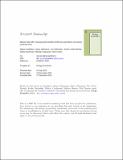Files in this item
Marine trade-offs: comparing the benefits of off-shore wind farms and marine protected areas
Item metadata
| dc.contributor.author | Karlõševa, Aljona | |
| dc.contributor.author | Nõmmann, Sulev | |
| dc.contributor.author | Nõmmann, Tea | |
| dc.contributor.author | Urbel-Piirsalu, Evelin | |
| dc.contributor.author | Budziński, Wiktor | |
| dc.contributor.author | Czajkowski, Mikołaj | |
| dc.contributor.author | Hanley, Nicholas David | |
| dc.date.accessioned | 2017-07-27T23:33:30Z | |
| dc.date.available | 2017-07-27T23:33:30Z | |
| dc.date.issued | 2016-03 | |
| dc.identifier | 240593269 | |
| dc.identifier | 3d67439e-a7bb-4a73-93e5-393e28f17b92 | |
| dc.identifier | 84958957549 | |
| dc.identifier | 000375358100012 | |
| dc.identifier.citation | Karlõševa , A , Nõmmann , S , Nõmmann , T , Urbel-Piirsalu , E , Budziński , W , Czajkowski , M & Hanley , N D 2016 , ' Marine trade-offs: comparing the benefits of off-shore wind farms and marine protected areas ' , Energy Economics , vol. 55 , pp. 127-134 . https://doi.org/10.1016/j.eneco.2015.12.022 | en |
| dc.identifier.issn | 0140-9883 | |
| dc.identifier.uri | https://hdl.handle.net/10023/11311 | |
| dc.description.abstract | The drive to increase renewable electricity production in many parts of Europe has led to an increasing concentration of new wind energy sites at sea. This results in a range of environmental impacts which should be taken into account in a benefit–cost analysis of such proposals. In this paper, we use choice modelling to investigate the relative gains and losses from siting new windfarms off the coast of Estonia, relative to the option of creating a new marine protected area. We find that, while respondents are generally opposed to converting marine shoals to conventional wind farms and prefer the establishment of marine protected areas instead, benefits from constructing ‘environmentally-friendly’ wind farms – an alternative program which is also considered by the government – are not statistically different with respect to consumers' welfare to those associated with creating a new marine protected area. Methodologically, the paper makes a contribution by showing the ability of the latent class mixed logit model to represent both within-and between-class preference heterogeneity, and thus its power to provide a more sophisticated representation of preference heterogeneity than stand-alone latent class or mixed logit approaches. The paper is also presents the first use of the latent class mixed logit model in willingness-to-pay space for environmental goods. | |
| dc.format.extent | 8 | |
| dc.format.extent | 759823 | |
| dc.language.iso | eng | |
| dc.relation.ispartof | Energy Economics | en |
| dc.subject | Discrete choice experiment | en |
| dc.subject | Off-shore wind energy | en |
| dc.subject | Marine protected areas | en |
| dc.subject | Willingness to pay space | en |
| dc.subject | Latent class mixed logit | en |
| dc.subject | Renewable energy | en |
| dc.subject | HB Economic Theory | en |
| dc.subject | DAS | en |
| dc.subject | SDG 7 - Affordable and Clean Energy | en |
| dc.subject | SDG 14 - Life Below Water | en |
| dc.subject.lcc | HB | en |
| dc.title | Marine trade-offs: comparing the benefits of off-shore wind farms and marine protected areas | en |
| dc.type | Journal article | en |
| dc.contributor.institution | University of St Andrews. Geography & Sustainable Development | en |
| dc.identifier.doi | 10.1016/j.eneco.2015.12.022 | |
| dc.description.status | Peer reviewed | en |
| dc.date.embargoedUntil | 2017-07-27 |
This item appears in the following Collection(s)
Items in the St Andrews Research Repository are protected by copyright, with all rights reserved, unless otherwise indicated.

